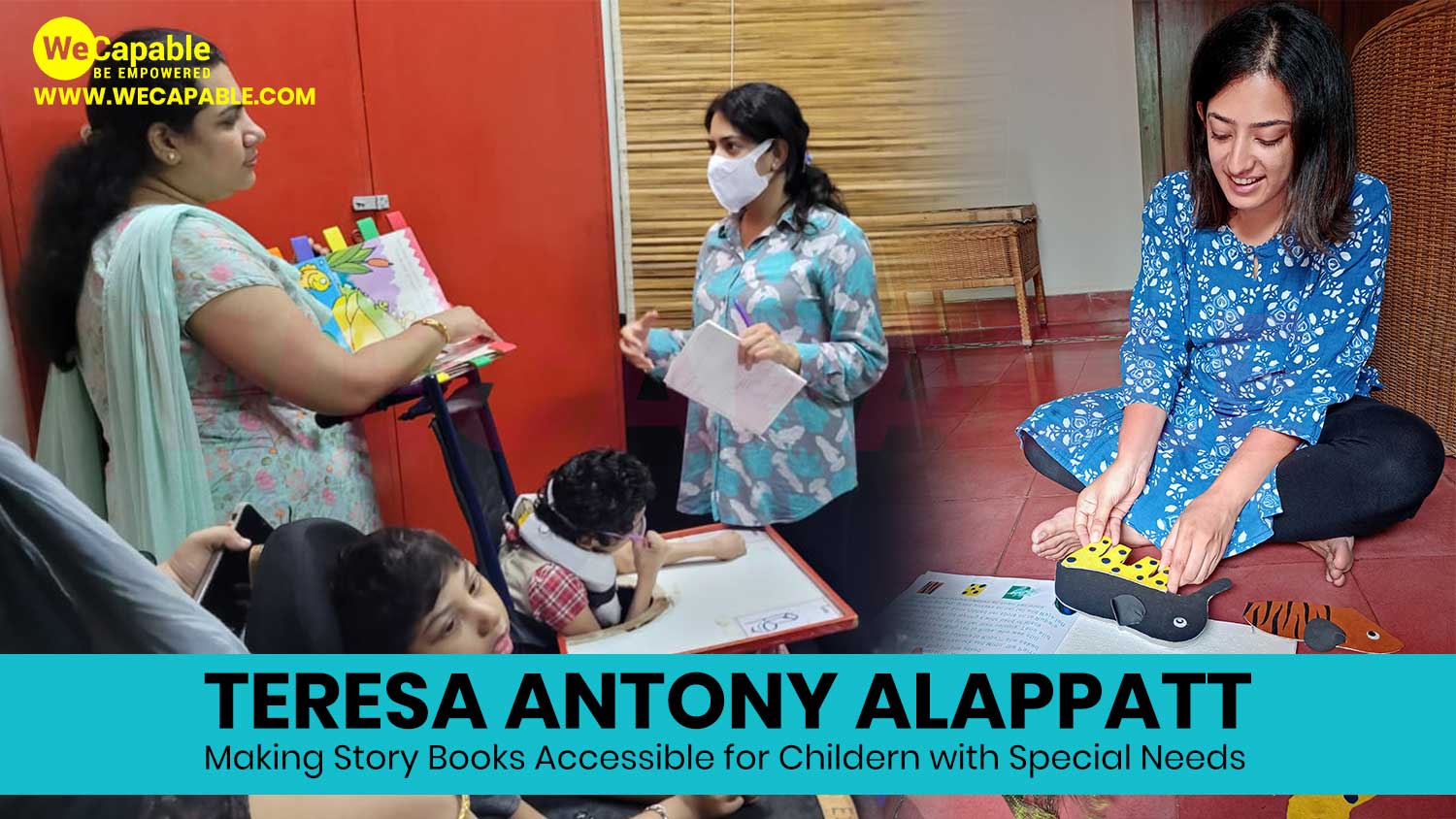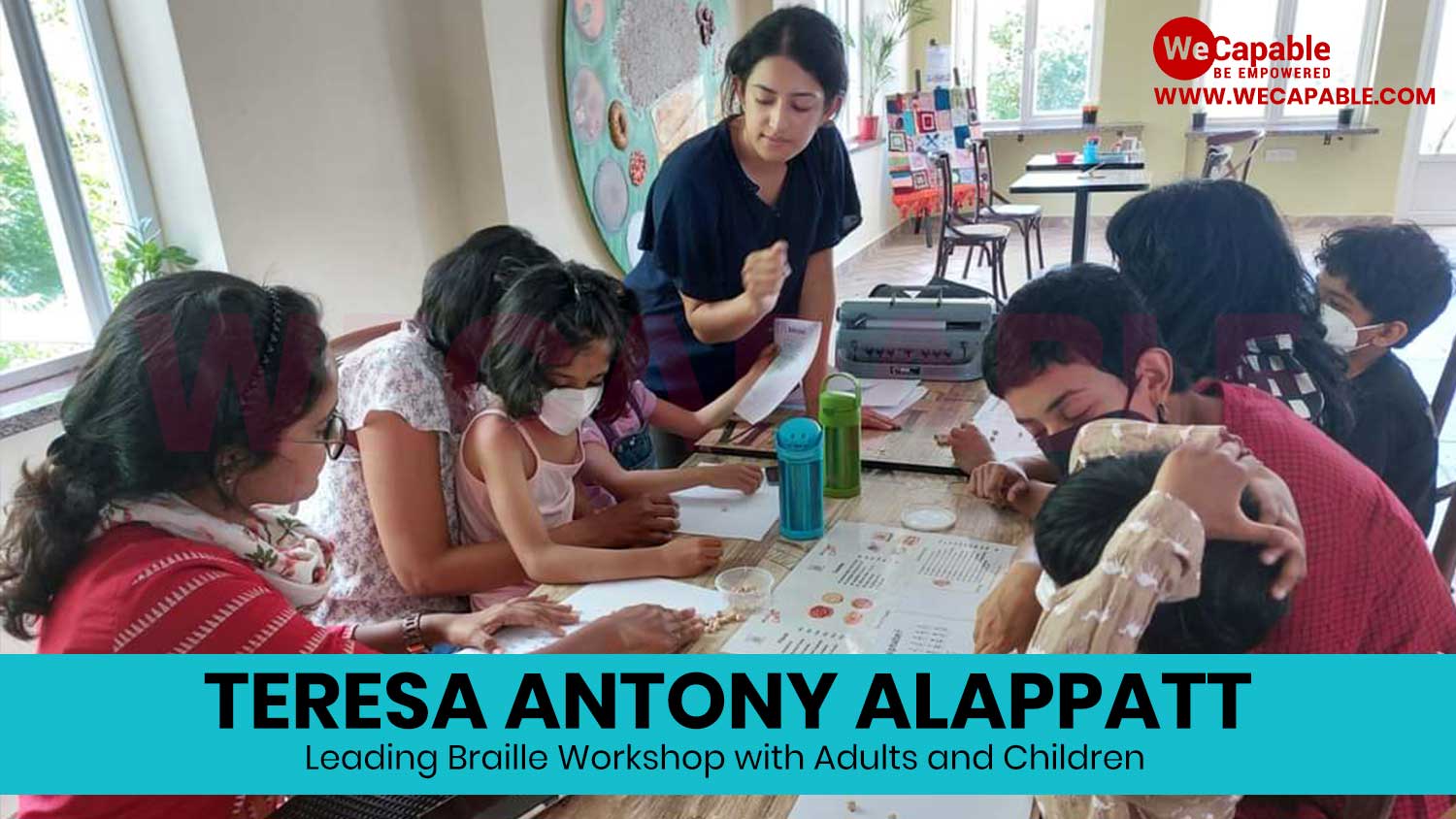Teresa Antony Alappatt was recently awarded with the NCPEDP-Mphasis Universal Design Award for her work in designing accessible books for children with low vision, attention deficit and other disabilities. At present, Teresa works as the Lead Inclusive Designer at the Chetana Cheritable Trust. WeCapable spoke with Teresa to find out more about her and her work.
WeCapable: Hello Teresa, congratulations on your award! To begin with, please tell us about yourself. Your family background, education etc.
Teresa Antony Alappatt: At the onset, I would like to begin by thanking WeCapable for giving my organization and I a platform to share our thoughts and learning.
I am currently the Lead Inclusive Designer at the Chetana Trust. Right from a young age I always had a flair for the arts. My parents encouraged both my brother and I to pursue our interests through school and college, an approach that made all the difference. I completed my Bachelor of Visual Arts at Stella Maris College, Chennai and soon began working at Chetana Trust. In my final year of college, I had explored various techniques in creating tactile graphics… a pursuit that would soon become my passion. I was enthralled with design being universal and inclusive and sought out to learn more on the topic.
Apart from creating accessible stories today, you would most likely see me dabbling with paints and other art media, playing with animals, and going for rides on my cycle.

WeCapable: What made you inclined towards designing inclusive graphics?
Teresa Antony Alappatt: I began my journey with Namita Jacob, Anu Alex and Arabhi Badri; the team that started the inclusive graphics library at Chetana Trust over 5 years ago. I came in as a visual arts student, exploring a little thought they had planted in my head… the thought of ‘illustration for the blind’. What began as a project, became a passion and soon I was learning everything I could to bring the joy of reading to all children.
Reading along with children helped me grow into a more inclusive designer. I was able to understand their needs of access and sought out to make more accessible story books. As a starter, I learnt braille and the principles of illustration so that the children with low vision or attention deficit could enjoy the imagery that children’s stories should hold. I experimented endlessly with ways of making images more real, more tactile and altogether more enjoyable. During the process, I learnt many lessons through my various interactions with children and creation of books, but one learning that stood out the most was that tactile stories are universally enjoyed by all children.
WeCapable: What exactly is accessible imagery?
Teresa Antony Alappatt: In a crux, accessible imagery are those images that are accessible to any person with a print disability. Story books stretch the boundaries between reality and fantasy, helping children imagine the impossible. Story books give children a way to know about people who think and live differently from those around them. They open otherwise hidden aspects of the world to children. While important for all children, such opportunities are immeasurably valuable for children with disabilities whose lives may be restricted by the impairment as well as the physical and attitudinal barriers in their physical and social environment. Accessible imagery are those that meet the standards of low vision illustration and tactile imagery paired with large text. The images in itself are those that are clear, of high contrast and clutter free.

WeCapable: Tell us about Chetana Trust. What does this organization do?
Teresa Antony Alappatt: Chetana Charitable Trust was set up in 2004 in Chennai, India. The organization is committed to increase availability of environments and opportunities that promote learning and development for groups at risk such as children with disabilities and first generation learners. The main objective of the Trust is to raise awareness and support the development of solutions to socially relevant issues, particularly in the areas of health & education. Currently we have three thrust areas. The first is in addressing the quality of vision care in children who have other disabilities. 1000 children received direct benefit from the project over the ten year intensive phase.
Our work directly benefited eight organizations in the city and their staff and changed the nature of the professional training programs as well as service delivery. The project has therefore brought about system level change in professional preparation and services to children throughout the country. Today, Chetana is invited to be a part of National Consultations. We are contributing to two manuals created for ophthalmologists and a text book for rehabilitation workers in India.
The second thrust area is the development of Assistive Technology solutions for people with disabilities. We partner with CREATE, the Assistive Technology lab at IIT, Madras, Enability Foundation, and the national network of AT solutions, feeding the engineers with current issues and supporting testing of their products. Our contribution is also in creating training modules for parents and teachers and supporting people with disabilities to carry the message of the importance of AT in the lives of people with disabilities to the major decision makers in the field.
The third area of thrust is developing literacy in children with print disabilities. We now have both an online library (available free of cost) and our Accessible Reading Materials Library based in Chennai. At Chetana Trust, we
- Create accessible story books for children with vision impairment and blindness, intellectual impairment, autism, learning disabilities and impairments of attention and perception.
- Develop adaptations for children with cerebral palsy who cannot turn pages of normal books and make material they can hold and illustrated cards they can use to retell or discuss the stories.
- Use language leveling to help children with low language levels but normal social and emotional intelligence to read books their peers enjoy by writing it in simple language.
- Create tactile illustrations for children with visual impairment, with attention deficit, or with intellectual impairment as a way to help them attend to key features and better understand and enjoy stories.
The project began with developing materials that promote early literacy skills including tactile story books, lending learning materials to early intervention and early learning centers and working with publishing houses to develop solutions to creating accessible reading materials. When we reviewed our contribution, we realized that the impact on the children was not as deep as we would like. We decided to center our efforts in three areas – develop and test the efficacy of accessible books with children in Chennai, develop methods of guiding families and teachers in developing literacy skills in children with disabilities and working on raising awareness and skills among professionals engaged in creating literacy materials and among the general community in contributing to supporting literacy in children with print disabilities.
We also offer direct services the DeafBlind Community in India. We facilitate opportunities of learning and serve as access providers to the members of SEDB, the Society for the Empowerment of the DeafBlind, India.
WeCapable: Have you made effort towards mass production of the accessible literature that you design?
Teresa Antony Alappatt: Our library currently has about 400 books in our Accessible Reading Materials [ARM] library. We scramble every month to add at least 5 new books to meet the needs of the children who have been our members for a long time. Hand crafting books take time, effort, expertise and money and we are always on the look-out for easier ways to increase our stock. Many teachers and parents from across the country visit our library and ask how they may get books for their children.
We do teach them how to make books and share with them ‘making instructions’ for books we have created ourselves and books from the public market space that we have adapted. Most children’s books available don’t lend themselves to direct adaptation – we have usually had to remake the illustrations and retype the text and only then add on the elements that make it accessible to most members.
We then further adapt for the different needs per member child. Our willingness to do this ‘last mile’ problem solving has ensured that all children can actually benefit from the books. Over time, we have learnt that there is a subset of customization that works for most children in different combinations. Packaging all this wisdom gathered over the years of work with the children is challenging and it would take our sustained support to pass on all that we have learnt to new libraries.
We would like to see more libraries grow around the country as one way to develop scale and to enable this, we would like to see how we can package and share our knowledge more effectively. It is with this thought in mind, that we launched our online library which has freely available ready to print files for each story along with activities and instructions on adaptation. This means that anyone in the world can start a library of their own using our print files!
While we realize from our experience with children, that there will always be a need for handmade books to support the unique needs of children who have different disabilities, we would like to see at least some accessible books mass printed and available to children across the country. We have experimented with various methods of mass production and believe that publishing houses could now turn towards creating story books with access needs kept in mind as we support the designers and visualizers at the early stages of book production.
WeCapable: What are you doing these days? And future plans?
Teresa Antony Alappatt: I continue to work on accessible story books and mentor artists, illustrators, schools and universities in creating accessible images for children’s story books. A large part of my work now is to get the community involved, excited and willing to problem solve with us. My most cherished experience was working with a group of youth with complex and varied impairments to guide them in creating an accessible book for our library. Having two advisors and colleagues who are deafblind, needs special mention for the pure enjoyment and learning that relationship has brought me.
I continue to create stories and content that are compatible with screen readers, braille refreshable displays and switches. As an individual with a language barrier to now working across scripts in various Indian languages, including Indian sign language… taking this wonderful unconventional path straight out of college led me to meet new people, learn more than I could have ever deemed possible and most importantly made me realize my own capacity. With over 400 Accessible story books today, and an online library of over 100 books, I find myself tickled with new questions. I dream of creating new solutions that continue to be accessible to all.
WeCapable: Would you like to give a message to the readers of WeCapable.com?
Teresa Antony Alappatt: Join us in our quest to create more accessible libraries around the world! Do get in touch with us if you are interested in collaborating to create stories in your local languages.
Use the citation below to add this article to your bibliography
"Teresa Antony Alappatt: Designer of Accessible Story Books for Children." Wecapable.com. Web. October 22, 2024. <https://wecapable.com/teresa-antony-alappatt/>
Wecapable.com, "Teresa Antony Alappatt: Designer of Accessible Story Books for Children." Accessed October 22, 2024. https://wecapable.com/teresa-antony-alappatt/
"Teresa Antony Alappatt: Designer of Accessible Story Books for Children." (n.d.). Wecapable.com. Retrieved October 22, 2024 from https://wecapable.com/teresa-antony-alappatt/

Leave a Reply